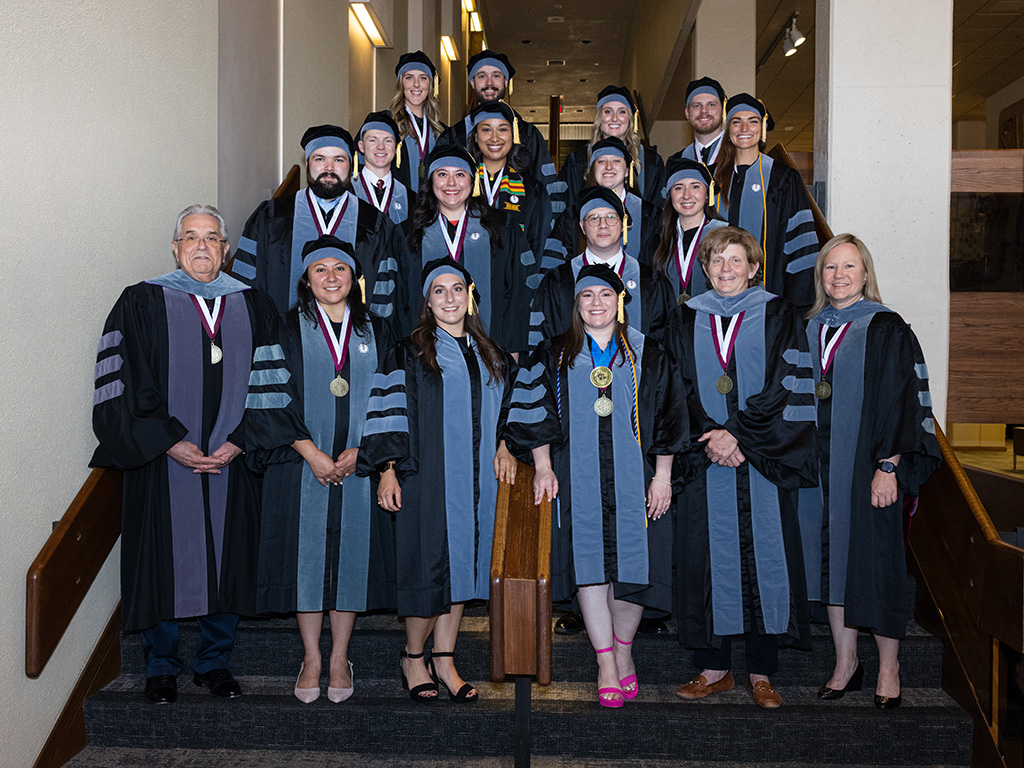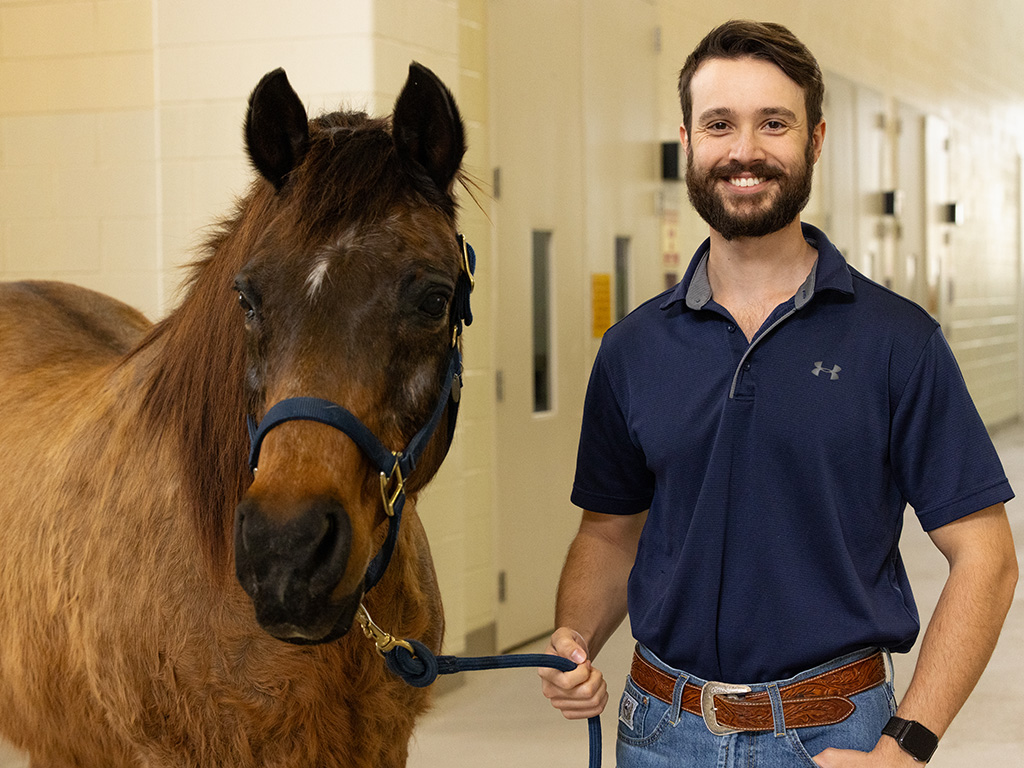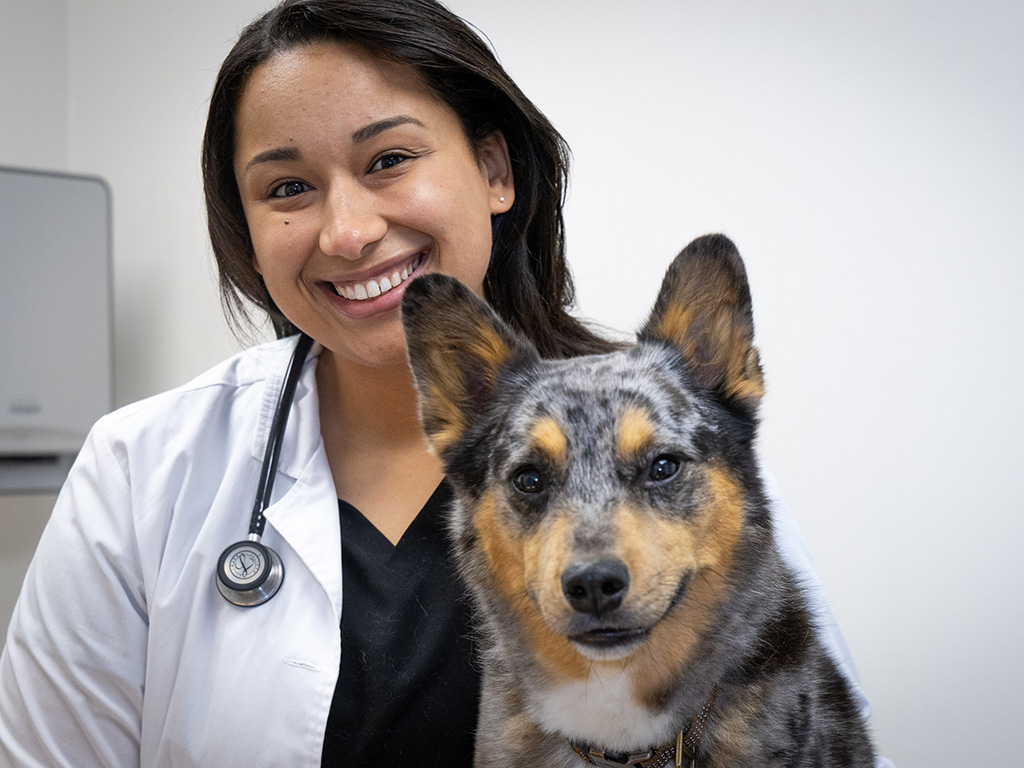First Class Of 2+2 DVM Students Completes Journey From Classroom To Career
Story by Ainsley Treesh, VMBS Marketing & Communications

Four years ago, the Texas A&M College of Veterinary Medicine & Biomedical Sciences (VMBS) began a new chapter as the first cohort of 2+2 Doctor of Veterinary Medicine (DVM) students began their education at the Veterinary Education, Research, & Outreach (VERO) campus in Canyon, Texas.
For the VERO campus, which was first opened in 2009 in partnership with the West Texas A&M University Paul Engler College of Agriculture & Natural Sciences, welcoming its first cohort of veterinary students was a major milestone, allowing the VMBS to further expand its presence as it served Texas Panhandle veterinarians, livestock producers, and citizens through impactful education, training, and outreach.
In May 2025, that program achieved another milestone, with the first cohort of 2+2 students earning their DVM degrees.
As they begin their careers, these students are utilizing their passions, skillsets, and the unique opportunities gleaned from their VERO experiences to better serve people, animals, and rural communities across the United States.
Fertile Ground For Unique Opportunities
When the VMBS welcomed its first 2+2 students in August 2021, Texas A&M’s Class of 2025 was the largest veterinary class in the nation, with 180 students. The program also became the first to be located within the same state as its “home” veterinary school.
And the uniqueness of the program hasn’t stopped there.
– Dr. Alexa Mendoza
“It’s the healthiest environment I’ve ever been in, in terms of seeing people work together, communicate with each other, and have each other’s backs. I really think that being the first class and the faculty being there for the first time solidified that relationship.”
With a third of the nation’s fed beef cattle supply located within two hours of VERO, the campus provides ample opportunities for students to gain exposure to large and mixed animal rural veterinary medicine. In addition, the smaller class size and an almost one-to-one student-to-faculty ratio provides VERO students with a unique opportunity to foster close relationships with faculty.
“There is an open-door policy for students with faculty members, and when you have that level of interaction on a daily basis, it really allows the faculty to know the students on a much more personal level,” said Dr. Kristin Chaney, VMBS assistant dean for professional programs curriculum and assessment. “Those interactions allow them to develop great collegiality and it’s almost like a family atmosphere.”
Since its inaugural year, the 2+2 program at VERO has seen great success, with interest and the number of applicants growing each year.
The students’ success is also reflected in their academic performance. At the beginning of the third year of vet school, Texas A&M DVM students take the Veterinary Educational Assessment (VEA), a standardized exam focusing on basic sciences as the foundation of veterinary medicine. The VEA has been identified as a strong indicator of how students will perform on the North American Veterinary Licensing Examination (NAVLE).
VERO students’ scores exceeded the national standard, indicating similar success is in store for the NAVLE.
“We are really pleased with the performance of the students who have been selected for the 2+2 program,” Chaney said. “The students have scored the same or better on the VEA as the College Station cohort. The 2+2 students have also been able to assimilate beautifully with the students when they transition from Canyon to College Station to begin their third year.”
For the inaugural cohort, the 2+2 program has provided a close-knit community and equipped them with the skills needed to begin their veterinary careers. Below, members of that first class share their experiences and where their next chapter will take them.
Alexa Mendoza

For El Paso native Alexa Mendoza, nothing is more important than giving back to her community, so she is working toward a career that will allow her to serve the border city where she grew up.
Although it was nerve-wracking to join the VERO program during its first year, Mendoza was confident the program would be a success.
“It had the backing of A&M and was the same curriculum the students in College Station were learning,” Mendoza said. “Now, it’s been the best thing that I could have ever imagined for me.”
With the students and faculty both being new to the program, bonds were formed quickly.
“It’s the healthiest environment I’ve ever been in, in terms of seeing people work together, communicate with each other, and have each other’s backs,” Mendoza said. “I really think that being the first class and the faculty being there for the first time solidified that relationship.”
The VERO program also connected Mendoza with Dr. Meriam Saleh, a clinical assistant professor, allowing her to research tick-borne diseases and the effect they have on animals and the food supply.
This interest inspired Mendoza to remain at the VMBS following her graduation to begin a Ph.D. program studying African Swine Fever with Saleh. She hopes to one day return to El Paso to work along the border, helping animal and human populations.
Park Phillips

For Park Phillips, the idea of becoming a veterinarian began to take shape at an early age, largely because of a couple of key people in his life.
“There were some veterinarians who were pretty big influences; they were people I admired and looked up to outside of the veterinary profession as well,” the Madisonville native said.
One of these individuals was Dr. Dan Posey, a VMBS clinical professor and the director of student recruitment and professional relationships at VERO. Posey’s influence led Phillips to choose the 2+2 program, where he thrived in the smaller class sizes and family-like community.
“The best things I got from VERO are my closest friends,” Phillips said. “You always ask questions like, ‘What if I did things differently? What if I went to a different school or went to vet school in College Station for all four years?’ But I definitely wouldn’t have changed my decision, if not for the education then for the relationships I made with classmates and faculty.”
Although Phillips’ first love is horses, during his time as a veterinary student, he explored a secondary interest in food animal medicine.
“I would like to complete a residency in a surgery program that sees both food animals and horses; that just aligns better with my goals,” he said. “I know a lot of equine vets who still see cattle, even in their solely equine practices, and that’s what I would want to do as well.”
Phillips is now completing an equine internship in California; after that, he hopes to further hone his skills by completing a residency in large animal surgery — one that would allow him to explore his food animal interest as well.
Christina Edlebeck

Christina Edlebeck has lived all over the world, allowing her to gain a deep understanding of the importance of building strong communities. No matter where she was, Edlebeck was drawn to animals, helping her realize her dream of becoming a veterinarian.
In 2021, Edlebeck graduated from Texas A&M with a bachelor’s degree in wildlife and fisheries science and a minor in public health before deciding to join the 2+2 program.
“Studying at VERO was an incredible experience,” Edlebeck said. “I have so many fond memories of the faculty there. Dr. Susan Eades, the head of the VERO program, is like a mama bear. She’s always looking out for us, though she’s also not afraid to beat us in a game of volleyball.”
Edlebeck’s experiences in the DVM program solidified her desire to fully embrace the community leadership element of veterinary medicine. After her second year, she attended the Veterinary Leadership Experience, a week-long intensive leadership training program hosted by the Veterinary Leadership Institute.
“One of the most important ideas I took away from the program was the concept of servant leadership,” she said. “When you are a veterinarian, you are a leader in your practice, and you need to step up and be committed to the personal growth of the people who work in the clinic with you.”
Edlebeck’s experiences in the DVM program solidified her desire to fully embrace the community leadership element of veterinary medicine, and she has joined the Rochelle Veterinary Hospital in Rochelle, Illinois, where she is eager to bring her leadership to the practice and rural community.
Hannah Garthwaite

While the VERO program wasn’t Hannah Garthwaite’s original plan, she is incredibly grateful to be a part of the inaugural class.
Originally from rural Ohio, Garthwaite found herself in the Texas Panhandle as she pursued her bachelor’s degree in animal science at West Texas A&M University.
Garthwaite was previously enrolled in another DVM program until a life-threatening medical issue required her to withdraw. While devastating at the time, this setback allowed Garthwaite to meet Posey, who encouraged her to apply to the 2+2 program.
“As a small-town kid who appreciates face-to-face conversations and hands-on learning opportunities, VERO was the perfect fit for me,” Garthwaite said. “VERO is more than just a vet school — it’s a family. Not only did the professors know my name but they wholeheartedly cared about my education and well-being.”
The VERO faculty were deliberate in making Garthwaite and her classmates’ transition to College Station for their third and fourth years of veterinary school as smooth as possible.
“It was a bit of an adjustment for me, but Dr. Karen Cornell, associate dean for professional programs, and Dr. Eades bent over backwards to help make the transition as smooth as possible,” Garthwaite said.
Garthwaite has moved to Santa Fe, New Mexico, where she has started an equine internship with Thal Equine Clinic. She is grateful for the life-long friendships she made with her peers in the VERO program and is excited to support them as they all begin their careers.


